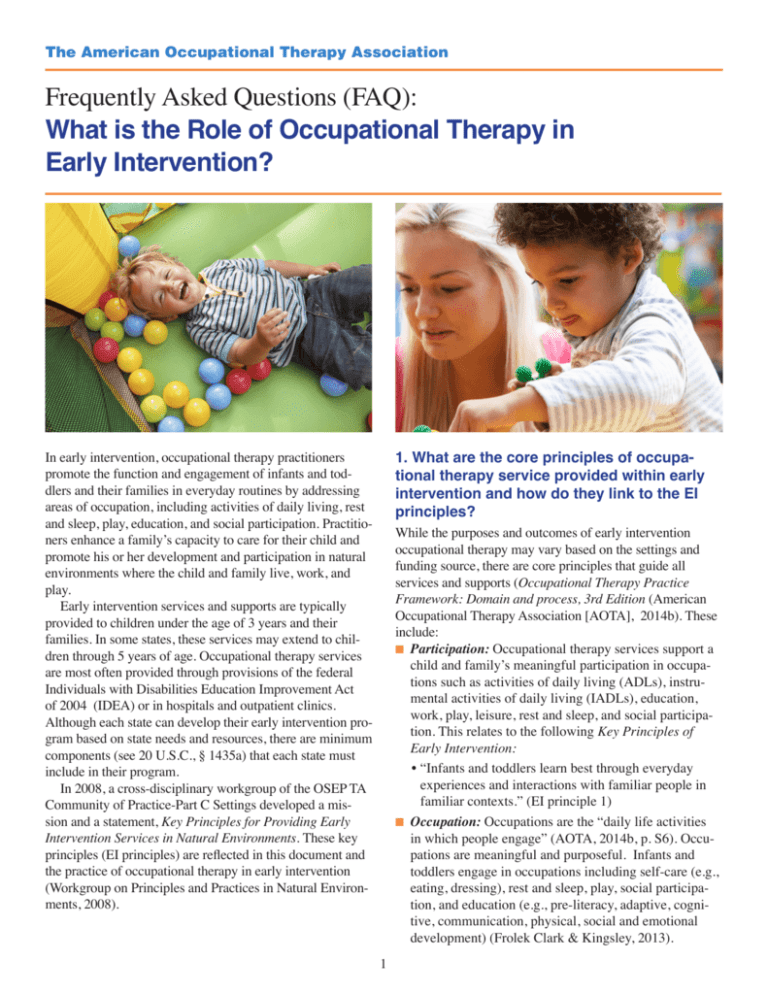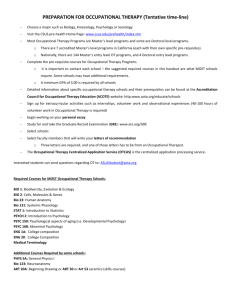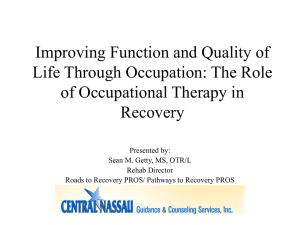
The American Occupational Therapy Association
Frequently Asked Questions (FAQ):
What is the Role of Occupational Therapy in
Early Intervention?
In early intervention, occupational therapy practitioners
promote the function and engagement of infants and toddlers and their families in everyday routines by addressing
areas of occupation, including activities of daily living, rest
and sleep, play, education, and social participation. Practitioners enhance a family’s capacity to care for their child and
promote his or her development and participation in natural
environments where the child and family live, work, and
play.
Early intervention services and supports are typically
provided to children under the age of 3 years and their
families. In some states, these services may extend to children through 5 years of age. Occupational therapy services
are most often provided through provisions of the federal
Individuals with Disabilities Education Improvement Act
of 2004 (IDEA) or in hospitals and outpatient clinics.
Although each state can develop their early intervention program based on state needs and resources, there are minimum
components (see 20 U.S.C., § 1435a) that each state must
include in their program.
In 2008, a cross-disciplinary workgroup of the OSEP TA
Community of Practice-Part C Settings developed a mission and a statement, Key Principles for Providing Early
Intervention Services in Natural Environments. These key
principles (EI principles) are reflected in this document and
the practice of occupational therapy in early intervention
(Workgroup on Principles and Practices in Natural Environments, 2008).
1. What are the core principles of occupational therapy service provided within early
intervention and how do they link to the EI
principles?
While the purposes and outcomes of early intervention
occupational therapy may vary based on the settings and
funding source, there are core principles that guide all
services and supports (Occupational Therapy Practice
Framework: Domain and process, 3rd Edition (American
Occupational Therapy Association [AOTA], 2014b). These
include:
n Participation: Occupational therapy services support a
child and family’s meaningful participation in occupations such as activities of daily living (ADLs), instrumental activities of daily living (IADLs), education,
work, play, leisure, rest and sleep, and social participation. This relates to the following Key Principles of
Early Intervention:
•“Infants and toddlers learn best through everyday
experiences and interactions with familiar people in
familiar contexts.” (EI principle 1)
n Occupation: Occupations are the “daily life activities
in which people engage” (AOTA, 2014b, p. S6). Occupations are meaningful and purposeful. Infants and
toddlers engage in occupations including self-care (e.g.,
eating, dressing), rest and sleep, play, social participation, and education (e.g., pre-literacy, adaptive, cognitive, communication, physical, social and emotional
development) (Frolek Clark & Kingsley, 2013).
1
Natural Environment: Services under IDEA Part C
must be provided in settings that are typical for the
child’s peers of comparable age, to the extent practicable. Whenever possible for the child and family, services should be provided in a family and/or community
setting. Occupational therapy practitioners understand
and analyze the interrelated conditions of context and
environment and the influence on participation and performance. This relates to the following Key Principles
of Early Intervention:
•“Infants and toddlers learn best through everyday
experiences and interactions with familiar people in
familiar contexts” (EI principle 1).
n Family Routines and Rituals: The Occupational
Therapy Practice Framework: Domain and Process, 3rd
Edition (AOTA, 2014b) defines routines as “patterns of
behavior that are observable, regular and repetitive, and
that provide structure for daily life” (p. S27). Occupational therapy practitioners promote the participation
of children and their families in everyday activities or
occupations, such as morning, bedtime, bath time, and
playtime routines. When there is a particular area of
concern, the occupational therapy practitioner can create
an individualized strategy based on the specific needs
and priorities of the child and family in order to promote successful participation in daily routines (AOTA,
2013a). Rituals add meaning and purpose and help
families build strong relationships. This relates to the
following Key Principles of Early Intervention:
•“The early intervention process, from initial contact
through transition, must be dynamic and individualized to reflect the child’s and family members’
preferences, learning styles and cultural beliefs.” (EI
principle 4)
n Culturally Sensitive: Occupational therapy practitioners recognize and support the value and importance
of culturally sensitive practice. Occupational therapy
practitioners support a child and family’s engagement
in culturally meaningful occupations and recognize that
culture influences the choice of activities in which an
individual engages (AOTA, 2013b). This relates to the
following Key Principles of Early Intervention:
•Each family’s culture, spiritual beliefs and activities,
values and traditions may be different from those of
the service provider. Service providers should seek to
understand, not judge. (Based on EI principle 4)
n Evidence-Based: Occupational therapy is a sciencedriven profession that applies the most up-to-date
research to service delivery. Evidence supports the
effectiveness of adding an occupational therapy practitioner to a treatment plan and the Individualized Family
Service Plan (IFSP) team (Case-Smith, 2013a; CaseSmith, 2013b; Case-Smith, Frolek Clark, & Schlabach,
Co-occupations are especially important for infants and
toddlers and their families. Co-occupations are occupations or activities that are shared between children,
family members, peers and other adults, and implicitly
involve two or more individuals. Examples of cooccupations include feeding and eating, caregiver-child
play, dressing, bathing, and hygiene. This relates to the
following Key Principles of Early Intervention:
•Learning opportunities must be functional, based on
child and family interest and enjoyment. (Based on EI
principle 1)
n Family-Centered: The family-centered philosophy is a
model whereby the family defines the priorities of the
intervention. It is based on the premises that families
know their children best, that optimal developmental
outcomes occur within a supportive family and community environment and that each family is unique. This
model aligns with the occupational therapy client-centered approach and the value that occupational therapy
practitioners place on collaborating with families
throughout the service delivery process (e.g., evaluation, intervention, outcomes) (AOTA, 2014b). Occupational therapy practitioners collaborate with the family
and other individuals who have knowledge of a child in
order to identify a child’s strengths and challenges. This
relates to the following Key Principles of Early Intervention:
•The consistent adults in a child’s life have the greatest
influence on their learning and development—not EI
providers. (Based on EI principle 2)
n Family Capacity and Resources: Occupational therapy
practitioners support and respect each family’s capacity and resources. Family capacity includes the knowledge and skills the family has to support their child’s
development and meet their child’s needs. Capacity is
the amount of physical, emotional and spiritual energy
necessary to support the development of a child, and
it directly influences the sense of competency a family member experiences when caring for a young child.
Resources include various supports that the family has
developed and can use to meet their family and child’s
needs (e.g., medical, home, financial). This relates to the
following Key Principles of Early Intervention:
•All families are resourceful, but all families do not
have equal access to the resources. Supports need to
build on strengths and reduce stressors so families are
able to engage with their children in mutually enjoyable interactions and activities. (Based on EI principle
2)
•“The primary role of a service provider in early intervention is to work with and support family members
and caregivers in children’s lives.” (EI principle 3)
n
2
2013; Frolek Clark & Schlabach, 2013; Howe & Wang,
2013; Kingsley & Mailloux, 2013). Interventions are
directed at the outcomes developed collaboratively with
the families and IFSP team members. Effective interventions are used to promote health, well-being, and
participation. Intervention approaches may be focused
on the environment, an activity, or the child or family or
both. ( See examples of these approaches on the Evidence-Based Practice page of our website.) This relates
to the following Key Principles of Early Intervention:
•“IFSP outcomes must be functional and based on
children’s and families’ needs and priorities.” (EI
principle 5). Each family understands that strategies
are worth working on because they lead to practical
improvements in the child’s and family’s lives.
•“Interventions with young children and family members must be based on explicit principles, validated
practices, best available research and relevant laws
and regulations” (EI principle 7).
tional regulation is an important aspect of the infant’s
mental health and develops within the context of the primary caregiver relationship (Koomar, 2009). Emotional
regulation occurs when the caregiver is responsive to
the needs of an infant or child and responds to his or her
emotional states appropriately during both stressful and
non-stressful events.
Occupational therapy practitioners support caregivers by emphasizing the strengths of the family and by
identifying strategies to build their capacity for resiliency,
which can influence mental health outcomes for both
a child and caregiver and change the trajectory of the
child and his or her family. For example, an occupational
therapy practitioner can recommend play strategies to
promote successful interactions between a toddler and his
older siblings or may assess how an infant’s (or caregiver’s) sensory processing affects the parent–infant relationship during daily routines (Dunn, 2004).
n Addressing a family’s capacity through education and
training. An occupational therapy practitioner can
address a family’s capacity by understanding the family’s
energy level for accomplishing everyday tasks and then
supporting all caregivers to help a child adapt and cope
with everyday life. For example, a practitioner can help
a caregiver clarify feelings and reactions and identify
which strategies have helped to ease these feelings in the
past. Occupational therapy practitioners also help build a
family’s capacity to care for and enjoy their child during
everyday activities by engaging the parents or other caregivers in a process of mutual reflection. They recognize
the power and potential of activity and daily routines to
enhance a partner’s knowledge and skill development.
n Promoting a child’s growth and development and participation in family and community life through the use
of occupation and adapting tasks and the environment.
An occupational therapy practitioner can help a caregiver
identify learning opportunities for a child throughout the
day that fit with daily routines by addressing ADLs, rest
and sleep, play, education, and social development. An
occupational therapy practitioner may recommend environmental or activity modifications to enhance a child’s
ability to participate fully in daily routines. For example,
an occupational therapy practitioner may suggest modifications to a high chair for proper positioning in order to
maximize a child’s ability to self-feed or engage in play.
An occupational therapy practitioner could also assist
in developing a bedtime routine for a child with poor
sensory processing to ensure sound sleep for the entire
family, or to enhance a child’s functioning to play successfully with friends at a birthday party.
n Empowering families to be advocates. Occupational
therapy practitioners support caregivers in being advocates for their child by helping caregivers feel confident
and comfortable in understanding and enjoying their
2. What types of services do occupational
therapy practitioners provide in early intervention?
Under IDEA Part C, occupational therapy is a primary
service. An occupational therapy practitioner may be the
sole service provider and can also work as part of a collaborative team that enhances a family’s capacity to care for
the child’s health and development within daily routines and
natural environments. Occupational therapists can provide
services as a primary service provider, service coordinator,
and/or as a member of an evaluation team.
Service Provider
Occupational therapy practitioners provide client-centered,
occupation-based services and supports to children and their
families in early intervention in the following ways:
n Fostering the bond between an infant or toddler and
his or her primary caregiver(s). Occupational therapy
practitioners use daily childhood activities such as play,
meal and sleep times to promote a secure attachment and
enhance a healthy bond that forms between the infant
and caregivers (Bowlby, 1988). The quality of the bond
has been found to influence developmental outcomes
in infants and children (Cassidy, 1999). Occupational
therapy practitioners support caregivers to recognize and
respond to a child’s cues to foster appropriate engagements and interactions. Being able to identify engagement and disengagement cues allows caregivers to
respond to their infant or child appropriately to promote
healthy bonding and attachment (Leerkes, Weaver, &
O’Brien, 2012). Appropriate responses to the child’s
emotional needs promote healthy co-occupations. Emo3
and other key caregivers in homes, childcare programs,
Early Head Start programs and other community settings. Children are eligible for a Part C program based on
their state’s criteria or definition of child with a disability.
Eligibility is typically determined by an infant or toddler
demonstrating a significant delay in one or more of five
developmental areas (cognitive, physical, communication,
social or emotional, and adaptive) or having a diagnosed
physical or mental condition that has a high probability of
resulting in a developmental delay. States may also choose
to provide early intervention services and supports to children who are at risk.
The IDEA Part C statute is optional and grants funds to
states if they meet the minimum requirements “to develop
and implement a statewide, comprehensive, coordinated,
multidisciplinary, interagency system that provides early
intervention services for infants and toddlers with disabilities and their families” (§ 1431(b)(1). These 16 minimum
requirements include services in natural environments, a
state interagency coordinating council and a public awareness program. A lead agency, determined by each state,
is responsible for overseeing this program, including the
funding. Often, the lead agency is the Department of Health
or Department of Education, but this varies by jurisdiction.
Some states provide services at no cost. Fees, if any, are
determined by the state’s lead agency, but a child cannot be
denied services because of his or her family’s ability to pay.
Additionally certain services such as evaluation and assessments, development of the IFSP, and service coordination
must be provided at no cost to families.
Services under the Medical Model
Occupational therapy services are offered in medical settings such as Neonatal Intensive Care Units (NICUs),
pediatric outpatient centers, hospitals, clinics or in a child’s
home. Typically the child must have a medical diagnosis in
order to bill for occupational therapy services under a medical model. These services to young children and families
are supported through private insurance, HMOs, PPOs and
other funding sources such as Medicaid.
child as well as planning for their child and family’s
future. In most states, when children turn 3 years of age,
they transition out of Part C early intervention services.
Practitioners can assist with this transition and assist
families in identifying the appropriate program and services, if needed. Occupational therapy practitioners can
enhance smooth transitions for a family and child by collaborating with service providers, promoting intra-agency
coordination, and communicating across settings and
systems. As service coordinators, occupational therapists
are responsible for meeting federal and state mandates
including holding a transition meeting with a family and
local school personnel to discuss options.
Service Coordinator
Under the IDEA, service coordinators guide families
through the Part C early intervention assessment, intervention, and transition process. They work for the coordination
and provision of early intervention services and supports
documented on the IFSP. Service coordinators support the
goal of the child and family making adequate progress
toward achieving family-directed outcomes. Some local
jurisdictions have dedicated service coordinators who only
provide service coordination services. In many areas, however, a service provider may also assume the responsibilities of a service coordinator. An occupational therapist may
be selected by the IFSP team to serve as a family’s service
coordinator and then would facilitate the team process for
developing an IFSP for each eligible child.
Multidisciplinary Evaluator
Under IDEA, a multidisciplinary team (defined by IDEA
as two or more professionals) uses diagnostic instruments
and procedures to determine a child’s eligibility for early
intervention services and supports. The role of this team, on
which an occupational therapist may be a qualified evaluator, is to assess the developmental skills of a child with
suspected delays and to conduct “a family-directed assessment of the resources, priorities, and concerns of the family
and the identification of the supports and services necessary
to enhance the family’s capacity to meet the developmental needs” of their child [(20 U.S.C. § 1436(a)(2))]. The
occupational therapist will use assessment results along with
family and other team member input to recommend services
as needed during the IFSP process.
4. How can occupational therapy services be
delivered and how are occupational therapy
practitioners qualified to offer service in EI?
Occupational therapists and occupational therapy assistants
have completed an accredited educational program curriculum, supervised fieldwork, and passed a national certification examination. Occupational therapists are considered
health, education, and human services professionals and
must meet any state licensure or credentialing requirements.
Some states require additional training or credentialing to
become service coordinators, providers, and evaluators in
early intervention. However, it is AOTA’s position that all
3. What are the legislative mandates and
payment sources that impact occupational
therapy in early intervention?
Services under the Individuals with Disabilities Education
Improvement Act (2004)-Part C
Early intervention occupational therapy services and supports are typically provided to young children, their families
4
a child’s eligibility assessment.) This definition used to be
used for the practices that are now described as interdisciplinary and may be found used in that way in older literature.
In an interdisciplinary team, each professional collaborates with other disciplines during the evaluation and
throughout the intervention processes, including co-treating
or working with the family. Family approval of the intervention plan is solicited and each professional is responsible
for the part of the plan related to his or her discipline. There
may be areas of overlap which often serve to support and
increase intervention effectiveness. For interdisciplinary
teams to be successful, there must be clearly defined roles
and responsibilities, ongoing communication among team
members (including the family) and a sense of value and
acceptance of each discipline’s expertise (Utley & Rapport,
2002).
In a transdisciplinary team, team members jointly assess
a child and form a coordinated intervention plan with family
members (King et al., 2009). A transdisciplinary team needs
to be highly collaborative with ongoing interaction of team
members and includes sharing expertise, knowledge and
skills (King et al., 2009). The joint intervention plan might
be implemented by a primary provider with the family.
Any member of the team may serve as the primary service
provider, and is typically chosen based on the needs of the
child and family.
The AOTA Practice Advisory on the Primary Provider
Approach in Early Intervention (2014a) states, “AOTA
does not endorse a transdisciplinary approach when service
providers are used interchangeably beyond their scope of
practice.” AOTA agrees that the IFSP team, including the
family, is most knowledgeable of the strengths and needs of
each child/family and determines the supports and services
they should receive, as well as the appropriate qualified
professionals who can implement the intervention plan.
More research is needed to determine which (or which combination of) team model or approaches leads to achieving
desired child and family outcomes (AOTA, 2010).
occupational therapists are appropriately trained and qualified to practice in the early intervention setting (AOTA,
2010). With appropriate supervision by an occupational
therapist, occupational therapy assistants are considered
qualified to administer early intervention practices in compliance with their state licensure and practice acts.
Occupational therapists and occupational therapy assistants may work directly with a child and should always support and educate key caregivers in incorporating therapeutic
activities within a child’s daily life. This includes ongoing
monitoring of a child’s progress and collaboration with
caregivers (i.e., families, child care providers) and educators
who implement a child’s IFSP or intervention plan.
AOTA endorses the concepts of collaboration, teamwork, and family-centered care. In early intervention, a
variety of team models may be utilized. The very nature of
that which occupational therapy addresses, engagement in
daily occupations, can be fostered in a number of ways that
can be identified by the occupational therapy practitioner
and implemented on a daily basis by the family or others
(AOTA, 2010). As practitioners of a primary developmental
service in early intervention, occupational therapy practitioners are ideally suited for a variety of roles within the IFSP
team. A child must always be evaluated by an occupational
therapist prior to the initiation of occupational therapy
services.
In a multidisciplinary team, each professional evaluates
a child from his/her disciplinary expertise and develops
and implements an intervention program for a child separate from other services. This model of team functioning
is no longer considered best practice in early intervention.
(Note: The IDEA’s mandate for a multidisciplinary assessment refers only to how many professionals participate in
5. What are some action steps and available
resources to help me advocate for my profession and role as an occupational therapy
practitioner in EI?
Occupational therapy practitioners can promote the profession and their role in Early Intervention through a variety of
activities such as:
n Conducting an in-service to advocate for and disseminate
information aboutoccupational therapy’s role in early
intervention
n Consider joining the AOTA EI workgroup (visit www.
aota.org) or the Cradle to College and Career practice
5
group of the IDEA Partnership (visit www.sharedwork.
org)
n Reviewing and sharing AOTA documents and resources
which guide EI practice. Numerous AOTA resources and
opportunities are available to advance the knowledge and
skills of practitioners who practice in early intervention.
These include:
•Pediatric Board Certification
•Special Interest Sections such as Early Intervention and
School SIS (EISSIS) and Developmental Disabilities
(DDSIS)
•OT Connection forums
•Professional newsletters and journals
•Specialized Knowledge and Skills Papers within the
Reference Manual of the Official Documents of AOTA,
13th edition
•Fact Sheets and Tip Sheets
•Continuing education products including one on Early
Childhood
Chandler, B. (Ed.) (2010). Early childhood: Occupational
therapy services for children birth to five. Bethesda, MD: AOTA
Press. Available from http://myaota.aota.org/shop_aota/prodview.aspx?TYPE=D&PID=984&SKU=1256
Resources From Other National
Organizations
Occupational therapy practitioners may also find Internet
resources from other professional organizations to be helpful in
providing information and evidence-based practices related to
early intervention.
Center for Parent Information and Resources
http://www.parentcenterhub.org/
Center on the Social and Emotional Foundations for Early
Learning
http://www.vanderbilt.edu/csefel/
Early Head Start National Resource Center
http://eclkc.ohs.acf.hhs.gov/hslc/tta-system/ehsnrc
IDEA Data Center
www.ideadata.org
AOTA Resources
Electronic versions of some documents and resources can be
found at the following websites:
American Occupational Therapy Association. (2014). Role of
occupational therapy with infants, toddlers, and families in
early intervention [PowerPoint slides]. Retrieved from http://
www.aota.org/-/media/Corporate/Files/Secure/Practice/Children/
EI.pdf
American Occupational Therapy Association. (2013). Childhood
occupations toolkit. Retrieved from http://www.aota.org/AboutOccupational-Therapy/Patients-Clients/ChildrenAndYouth.aspx
American Occupational Therapy Association. (2013). Letter of
response. Retrieved from http://www.aota.org/-/media/Corporate/Files/Practice/Children/Letter-to-Carol-Massanari-RRCPDec-24-2013.PDF
American Occupational Therapy Association. (2013). Occupational therapy and early intervention/early childhood [Special issue]. American Journal of Occupational Therapy, 67. Retrieved
from http://ajot.aotapress.net/content/67/4.toc
American Occupational Therapy Association. (2011). Occupational therapy services in early childhood and school-based
settings. Retrieved from http://www.aota.org/-/media/Corporate/
Files/Secure/Practice/OfficialDocs/Statements/OT-ServicesEarly-Childhood-and-Schools.pdf
American Occupational Therapy Association. (2010). Occupational therapy for young children: Birth through 5 years of age.
Retrieved from http://www.aota.org/-/media/Corporate/Files/
AboutOT/Professionals/WhatIsOT/CY/Fact-Sheets/FactSheetOTforYoungChildren.pdf
American Occupational Therapy Association. (2010). Specialized knowledge and skills for occupational therapy practice in
neonatal intensive care units. Retrieved from http://www.aota.
org/-/media/corporate/files/secure/practice/officialdocs/skills/
specialized%20ks%20nicu.pdf
IDEA Infant and Toddler Coordinators Association
http://www.ideainfanttoddler.org/
The Early Childhood Technical Assistance Center
http://ectacenter.org/
Orelena Hawks Puckett Institute and evidence-based
practices
http://www.puckett.org/
Technical Assistance Center on Social Emotional
Intervention for Young Children
http://www.challengingbehavior.org/
The Division for Early Childhood
http://www.dec-sped.org/
Tots ʼnTech Research Institute
http://tnt.asu.edu/
Zero To Three
http://www.zerotothree.org/
Regional Resource Center Program. (2012). Key principles of
early intervention and effective practices: A crosswalk with
statements from discipline-specific literature. Retrieved from
http://www.rrcprogram.org/cms2/images/_rrcpdata/documents/
KeyPrinciplesEI_effectivepractices.pdf
6
Howe, T-H., & Wang, T-N. (2013). Systematic review of interventions
used in or relevant to occupational therapy for children with feeding difficulties ages birth–5 years. American Journal of Occupational Therapy,
67, 405–412. http://dx.doi.org/10.5014/ajot.2013.004564
References
American Occupational Therapy Association. (2010). AOTA practice advisory on occupational therapy in early intervention. Retrieved
from http://www.aota.org/-/media/Corporate/Files/Practice/Children/
AOTA%20Practice%20Advisory%20on%20OT%20in%20EI%20%20
Final%20Draft%20cw%20_3_.pdf
Individuals With Disabilities Education Improvement Act of 2004. Pub.
L.108–446, 20 U.S.C. § 1400 et seq.
King, G., Strachan, D., Tucker, M., Duwyn, B., Desserud, S., & Shillington, M. (2009). The application of a transdisciplinary model for early
intervention services. Infants & Young Children, 22, 211–223.
American Occupational Therapy Association. (2013a). Tips for living life
to its fullest: Establishing morning routines for children. Retrieved from
http://www.aota.org/About-Occupational-Therapy/Patients-Clients/ChildrenAndYouth/Morning-Routines.aspx
Kingsley, K., & Mailloux, Z. (2013). Evidence for the effectiveness of
different service delivery models in early intervention services. American
Journal of Occupational Therapy, 67, 431–436. http://dx.doi.org/10.5014/
ajot.2013.006171
American Occupational Therapy Association. (2013b). Frequently asked
questions: How can occupational therapy strive towards culturally sensitive practices? Retrieved from http://www.aota.org/-/media/corporate/
files/secure/practice/multicultural/faqculturalsensitivity.pdf
Koomar, J. A. (2009, December). Trauma-and attachment-informed sensory integration assessment and intervention. Sensory Integration Special
Interest Section Quarterly, 32(4), 1–4.
American Occupational Therapy Association. (2014a). AOTA practice advisory on the primary provider approach in early intervention.
Retrieved from http://www.aota.org/-/media/Corporate/Files/Practice/
Children/AOTA-Advisory-on-Primary-Provider-in-EI.pdf
Leerkes, E. M., Weaver, J. M., O’Brien, M. (2012). Differentiating maternal sensitivity to infant distress and non-stress. Parenting: Science and
Practice, 12, 175–184.
American Occupational Therapy Association. (2014b). Occupational
therapy practice framework: Domain and process (3rd ed.). American
Journal of Occupational Therapy, 68, S1–S48. http://dx.doi.org/10.5014/
ajot.2014.682006
Utley, B., & Rapport, M. J. K. (2002). Essential elements of effective
teamwork: Shared understanding and differences between special educators and related service providers. Physical Disabilities: Education and
Related Services, 20, 9–47.
Bowlby, J. (1988). A secure base: Parent-child attachment and healthy
human development. New York: Basic Books.
Workgroup on Principles and Practices in Natural Environments, OSEP
TA Community of Practice: Part C Settings. (2008, March). Seven key
principles: Looks like/doesn’t look like. Retrieved from http://www.
ectacenter.org/~pdfs/topics/families/Principles_LooksLike_DoesntLookLike3_11_08.pdf
Case-Smith, J. (2013a). From the desk of the guest editor—Systematic
reviews of the effectiveness of interventions used in occupational therapy
early childhood services. American Journal of Occupational Therapy, 67,
379–382. http://dx.doi.org/10.5014/ajot.2013.007872
Case-Smith, J. (2013b). Systematic review of interventions to promote
social–emotional development in young children with or at risk for disability. American Journal of Occupational Therapy, 67, 395–404. http://
dx.doi.org/10.5014/ajot.2013.004713
Case-Smith, J., Frolek Clark, G. J., & Schlabach, T. L. (2013). Systematic review of interventions used in occupational therapy to promote
motor performance for children ages birth–5 years. American Journal of Occupational Therapy, 67, 413–424.http://dx.doi.org/10.5014/
ajot.2013.005959
This document was prepared for AOTA by
Ashley Stoffel, OTD, OTR/L and Rhonda Schleis,
MS, OTR/L.
Cassidy, J. (1999). The nature of the child’s ties. In J. Cassidy & P. R.
Shaver (Eds.), Handbook of attachment: Theory, research, and clinical
applications (pp. 3–20). New York: Guilford.
Copyright ©2014 by the American Occupational Therapy Association,
Inc. All rights reserved. This material may be copied and distributed for
educational use without prior written consent. For all other uses, please
email copyright@aota.org.
Dunn, W. (2004). A sensory processing approach to supporting infant
caregiver relations. In A. J. Sameroff, S. C. McDonough, & K. L. Rosenblum (Eds.), Treating parent-infant relationship problems. New York:
Guilford.
The American Occupational Therapy Association (AOTA)
represents the professional interests and concerns of more
than 140,000 occupational therapists, assistants, and students working in practice, science, education, and research.
Frolek Clark, G. J., & Kingsley, K. (2013). Occupational therapy practice
guidelines for early childhood: Birth through 5 years. Bethesda: AOTA
Press.
Frolek Clark, G. J., & Schlabach, T. L. (2013). Systematic review of
occupational therapy interventions to improve cognitive development in
children ages birth–5 years. American Journal of Occupational Therapy,
67, 425–430. http://dx.doi.org/10.5014/ajot.2013.006163
The American Occupational Therapy Association
4720 Montgomery Lane, Bethesda, MD 20814
301-652-AOTA (2682)
www.aota.org
Occupational Therapy: Living Life To Its Fullest®
7







